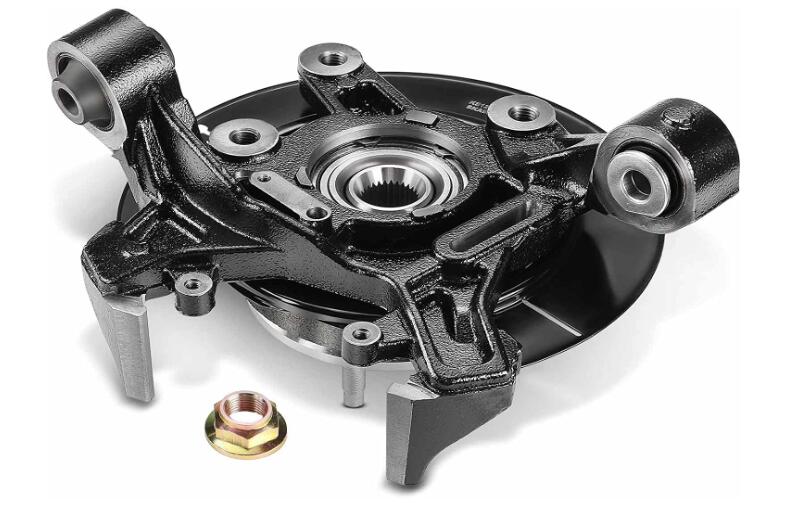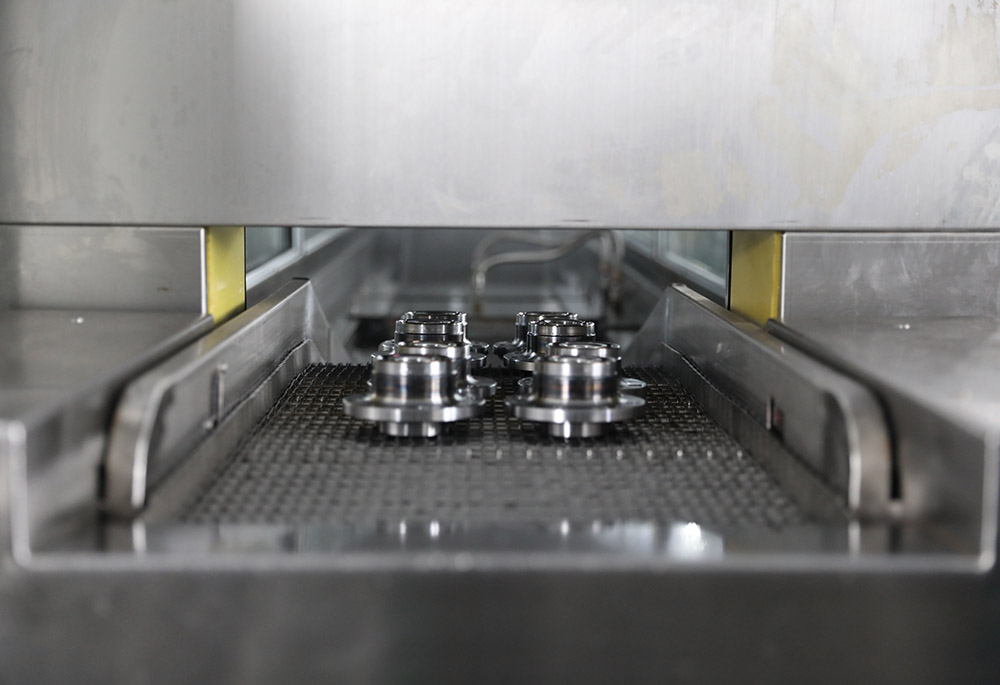Introduction:
The wheel hub plays a critical role in vehicle performance and safety in the automotive world.
This integral component connects the wheel to the axle, ensuring a seamless power transfer from the drivetrain to the wheels.
The manufacturing process of wheel hubs significantly influences their characteristics and performance, with forging and casting being the two main methods.
Despite serving the same function, forged and cast wheel hubs differ remarkably in their manufacturing process, strength and durability, weight, cost, and design flexibility.
This blog post aims to delve into these differences, providing an in-depth and comprehensive understanding of their distinctiveness.
1. Manufacturing Process: The Core of Creation
The initial and most significant difference between forged and cast wheel hubs is their manufacturing processes.
Forging is a process where a solid piece of metal, often steel or aluminum, is heated until it becomes malleable.
It’s then mechanically deformed under high pressure into the desired shape.
Heavy machinery “hammers” or “presses” the metal into the body in a process involving multiple heating and forming stages and forging, yielding a wheel hub that is very strong and durable due to the alignment and stretching of the metal’s grain structure during the process.
On the other hand, casting involves heating the metal until it becomes liquid.
This molten metal is then poured into a mold that mirrors the desired shape of the wheel hub.
Once the molten metal cools and solidifies, the mold is removed, revealing the wheel hub.
Though casting can produce various shapes and sizes, the resultant wheel hubs typically have a more random and porous grain structure than forged ones.
2. Strength and Durability: The Test of Time
The manufacturing processes of forging and casting lead to differences in the strength and durability of the resultant wheel hubs.
Forged wheel hubs benefit from the alignment and stretching of the metal’s grain structure during the forging process.
This manipulation at a microstructural level results in wheel hubs that are substantially stronger and more durable than their cast counterparts.
Forged hubs are renowned for their ability to withstand high loads and harsh conditions, making them a popular choice for heavy-duty and performance-oriented applications.
Despite their toughness, forged hubs also display an impressive resistance to wear and tear, often outlasting their cast equivalents.
In contrast, despite improvements in modern casting techniques, cast wheel hubs still exhibit a more random and porous grain structure.
This structural randomness can result in cast hubs needing to be more robust and durable when compared to forged hubs.
However, it’s important to note that cast wheel hubs can still offer ample strength and durability for many standard automotive applications.
3. Weight: The Scale of Efficiency
Weight is crucial to vehicle performance and fuel efficiency when discussing automotive components.
Despite their superior strength, forged wheel hubs often weigh less than cast ones.
This paradox can be attributed to the enhanced grain structure of forged hubs, which allows less material to achieve the same, if not greater, strength.
This lighter weight can substantially improve vehicle performance by reducing unsprung weight, a crucial factor in suspension response.
Conversely, cast wheel hubs are generally heavier because they require more material to match the strength provided by a forged hub.
While this increased weight doesn’t offer performance benefits, it’s not necessarily a significant disadvantage in standard automotive applications where ultimate performance isn’t the priority.
4. Cost: The Price of Performance
Like any other component, the cost of wheel hubs plays a critical role in their selection for various applications.
Due to its more complex and labor-intensive nature, the forging process typically makes forged wheel hubs more expensive than cast ones.
However, the additional cost can be justified by the exceptional strength, durability, and lightness that forged hubs offer.
These qualities make them preferred for demanding applications such as commercial vehicles and performance cars.
In contrast, casting is a more efficient and straightforward manufacturing process, resulting in less expensive wheel hubs.
Cast hubs’ cost-effectiveness and adequate performance for many applications make them popular for standard passenger cars and light-duty vehicles.
5. Design Flexibility: The Shape of Success
The capability to incorporate intricate designs into wheel hubs also varies between forging and casting.
Forging tends to offer less design flexibility than casting.
The forging process is more suited to creating simple, streamlined shapes, as it’s challenging to forge intricate designs through hammering or pressing.
In contrast, casting offers superior design flexibility.
Using a mold allows the molten metal to flow into intricate designs, allowing manufacturers to create more complex wheel hub shapes with relative ease.
This flexibility can be advantageous in creating aesthetically pleasing wheel hubs or when a unique hub design is necessary for specific vehicle applications.
6. Aesthetics: Beauty in Strength
The aesthetic appeal of a wheel hub, while less critical than the structural and functional attributes, plays a role in a vehicle’s overall appeal.
Forged and cast wheel hubs differ in this respect as well.
Forged wheel hubs typically have a more streamlined, clean aesthetic due to the limitations of the forging process.
However, the lack of intricate designs doesn’t mean a lack of beauty.
The simplicity of forged wheel hubs can add a classic, rugged charm to a vehicle, complementing its overall design.
On the other hand, cast wheel hubs can incorporate intricate designs and detailing. This flexibility can allow for more creative and unique aesthetics.
From sleek lines to complex patterns, casting can bring a designer’s vision to life in a way that forging cannot.
Thus, cast wheel hubs may offer more options if aesthetic customization is a priority.
7. Repair and Maintenance: The Costs Beyond Purchase
Over the lifespan of a vehicle, wheel hubs require maintenance and, at times, repair.
The difference in the manufacturing process of forged and cast wheel hubs also influences their maintenance and repair requirements.
Thanks to their superior strength and durability, forged wheel hubs typically require less frequent maintenance and are less likely to need repair.
Even in damage, forged wheel hubs can sometimes be repaired, depending on the extent and type of injury.
On the other hand, while cast wheel hubs are cost-effective initially, they may require more regular maintenance due to their less robust structure.
Furthermore, repairing cast seats is often more complicated or even impossible.
They usually need to be replaced when damaged, potentially increasing long-term costs.
8. Environmental Impact: Manufacturing’s Footprint
In the era of increasing environmental consciousness, the ecological impact of manufacturing processes is an essential consideration.
Due to its high energy requirements for heating and deforming metal, forging has a higher carbon footprint than casting.
Additionally, forging can result in significant material wastage if the process needs to be optimized.
Conversely, casting is a more energy-efficient process and usually results in less material waste since the molten metal is directly poured into a mold of the final shape.
This reduced energy consumption and waste makes casting a more environmentally friendly option.
9. Application: The Right Fit for the Job
A pivotal aspect that dictates the choice between forged and cast wheel hubs is the intended application.
Each manufacturing process yields a product with unique characteristics that cater to specific needs.
Due to their high strength and lower weight, forged wheel hubs are commonly used in applications where performance is paramount.
They’re a staple in motorsports, luxury vehicles, and heavy-duty commercial vehicles.
Their ability to withstand high stresses while reducing unsprung weight contributes significantly to vehicle performance and longevity.
On the contrary, with their cost-effectiveness and design flexibility, cast wheel hubs find extensive usage in passenger vehicles and light-duty applications.
They provide an affordable and aesthetically versatile solution without compromising these applications’ necessary safety and performance attributes.
10. Future Innovations: Advancing the Wheel Hub Technology
The world of wheel hub manufacturing is dynamic. It continues to evolve with technological advancements, improving the characteristics and performance of both forged and cast wheel hubs.
In forging technology, advancements are focused on enhancing the grain structure further, reducing weight, and minimizing the process’s environmental impact.
New techniques, like precision forging and advances in material science, promise to deliver even more robust and lighter wheel hubs.
On the other hand, casting technology is improving the strength and durability of cast wheel hubs.
Innovations like high-pressure die casting and better alloys aim to reduce the grain structure’s porosity and randomness, leading to more vital, durable cast wheel hubs.
Conclusion: The Road Ahead
Choosing between forged and cast wheel hubs is multifaceted, considering various factors, from cost to strength, weight, and aesthetics.
As we move forward, the lines between these two manufacturing processes will blur, each borrowing advancements from the other.
In the future, we may see cast wheel hubs with strength rivaling their forged counterparts or forged wheel hubs matching the design flexibility of cast hubs.
Until then, the choice between forged and cast remains a matter of matching the right wheel hub to the proper application, ensuring optimal performance, safety, and satisfaction.




